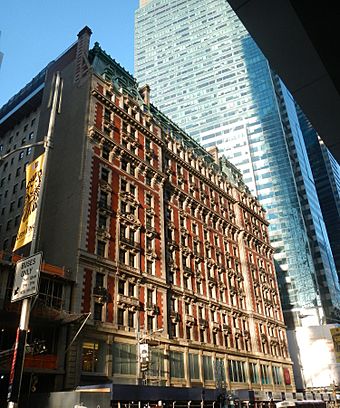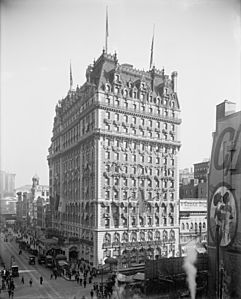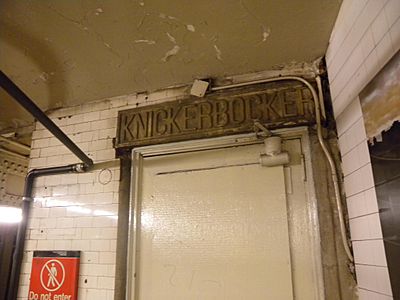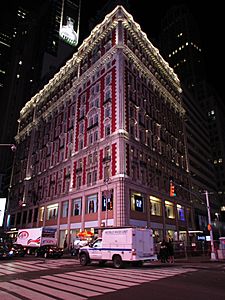The Knickerbocker Hotel facts for kids
|
The Knickerbocker Hotel
|
|

Seen from beside the Bank of America Tower on 42nd Street, 2012
|
|
| Location | 142 West 42nd Street New York, NY 10036 |
|---|---|
| Area | ~ 300,000 square feet (28,000 m2) |
| Built | 1901 or 1906 |
| Architect | Trowbridge & Livingston; Marvin & Davis; Price, Bruce |
| Architectural style | Beaux Arts |
| NRHP reference No. | 80002697 |
Quick facts for kids Significant dates |
|
| Added to NRHP | April 11, 1980 |
The Knickerbocker Hotel is a famous building in Times Square, Manhattan, New York City. It stands at the corner of Broadway and 42nd Street. The name "Knickerbocker" is a historic Dutch name linked to New York City.
This grand hotel was built by John Jacob Astor IV in the early 1900s. It was a symbol of luxury and wealth. Famous people like opera singer Enrico Caruso and entertainer George M. Cohan once lived there.
After 15 years, the hotel closed due to money problems. It was then changed into an office building in 1920. For a time, it was home to Newsweek magazine. Later, it became known as 6 Times Square. In 2013-2015, the building was renovated and reopened as a hotel, going back to its original name.
The Knickerbocker Hotel is built in the Beaux-Arts style. It features red brick, special terracotta details, and a unique sloped roof. It was added to the National Register of Historic Places in 1980. It also became a New York City Landmark in 1988.
Contents
History of the Knickerbocker Hotel
Building the Original Hotel
Construction on the hotel began in 1903. A development group from Philadelphia started the project. They hired architects Bruce Price and Marvin & Davis to design the building.
However, the group ran into financial trouble in 1904. The building was left unfinished, with only its outer walls complete. In 1905, John Jacob Astor IV took over the project. He hired new architects, Trowbridge & Livingston, to finish the inside. They had also designed his St. Regis Hotel.
The Hotel's Grand Opening
The Knickerbocker Hotel officially opened on October 23, 1906. It quickly became a popular spot in New York City. The hotel cost $3.3 million to build. It had 556 rooms and fancy restaurants and bars. These could seat 2,000 people for dinner after theater shows.
Famous artist Maxfield Parrish painted a large 30-foot mural for the bar. It showed Old King Cole. Other artists like Frederic Remington also added decorations. The bar became so popular that people called it "The 42nd Street Country Club."
Famous Guests and Stories
One story says that the hotel's bartender invented the martini in 1912. He supposedly mixed dry vermouth and gin. However, this story is likely not true. The actual origin of the martini is thought to be from a different drink called "the Martinez."
The world-famous opera singer Enrico Caruso lived at the hotel for many years. He always ate his meals in the hotel restaurant. On Armistice Day, Caruso once sang "The Star-Spangled Banner" from his window. He even gave his coat to a homeless man outside the hotel.
Closing as a Hotel
John Jacob Astor IV died in 1912 on the Titanic. His son, Vincent Astor, then inherited the hotel. It continued to do well until 1920, when its manager retired.
Around this time, a law called Prohibition made it illegal to sell alcohol. This greatly hurt the hotel's business, especially its popular bars and restaurants. Because of this, Vincent Astor decided to close the hotel. He chose to turn the building into offices instead.
The Knickerbocker as an Office Building
Vincent Astor hired architect Charles A. Platt to redesign the building. The luxurious hotel interiors were completely removed. The ground floors became stores, and the rest of the building was rebuilt as offices.
The famous Old King Cole painting was moved. It was first loaned to a club, then permanently installed at the St. Regis Hotel in 1935. From 1940 to 1959, the building was home to Newsweek magazine. It was known as the Newsweek Building during this time.
By the 1970s, a businessman named Harry Helmsley operated the building. In 1980, the building was converted into showrooms and studios. These were used by companies from the Garment District. On April 11, 1980, the building was listed on the National Register of Historic Places.
The Hotel Reopens
In 2004, the building, then called 6 Times Square, was sold to a new owner. It was sold again in 2006 to an investment group from Dubai. This group planned to turn it back into a five-star hotel. However, they faced financial difficulties and lost the property in 2010.
In 2012, a U.S. real estate company called FelCor Lodging Trust bought the building for $115 million. They spent another $115 million to renovate it. The inside was completely redone, but the historic outside was kept. The building was transformed into a modern 330-room hotel.
The hotel reopened on February 12, 2015, with its original name, The Knickerbocker Hotel. It has 300 rooms, including many suites. It also features a restaurant, a coffee shop, and a rooftop bar with views of Times Square.
You can find a sign for the hotel in the New York City Subway's Times Square station. The "Knickerbocker" sign is above a doorway that once connected directly to the hotel.
Gallery
See also
 In Spanish: The Knickerbocker Hotel para niños
In Spanish: The Knickerbocker Hotel para niños








